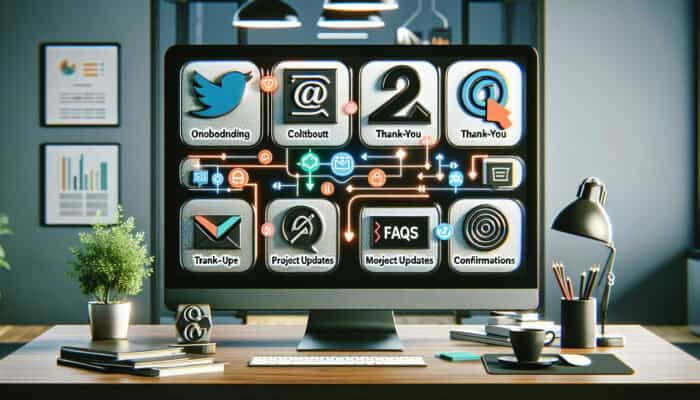Powerful Techniques for Efficient Email Sorting to Maximize Your Productivity
Effective Strategies to Elevate Your Email Productivity

Efficiently sorting your emails is critical for achieving effective email management, particularly for virtual assistants. Establishing a strong categorization system for your emails—whether by creating specific folders or applying a labelling strategy—enables you to quickly retrieve essential messages and significantly boosts your productivity. A well-organized email structure can drastically minimize the time you waste sifting through a chaotic inbox. Consider implementing the following key sorting techniques to enhance your workflow:
- Dedicated Folder Creation: Set up specific folders for different clients, projects, or topics to ensure that incoming emails are automatically organized as they arrive.
- Colour-Coded Labeling System: Use a system of color-coded labels to visually distinguish between emails that are urgent, important, or purely informational.
- Subfolder Organization: Create subfolders within your primary categories for even more precise organization of related emails.
- Automated Rules and Filters: Establish automatic rules to direct emails from certain senders or those containing specific keywords into the appropriate folders without manual sorting.
- Flagging or Starring Important Emails: Use flags or stars to mark messages that require your immediate attention or action, ensuring nothing is overlooked.
- Regular Archiving of Non-Essential Emails: Make it a habit to archive emails that you no longer need actively but may require in the future.
- Utilizing Advanced Search Features: Get acquainted with advanced search functionalities to quickly find emails without scrolling through the entire inbox.
Implementing these sorting techniques not only streamlines your email management but also enables you to focus on critical tasks, allowing you to manage your time more effectively as a virtual assistant.
Strategies to Effectively Prioritize Emails for Optimal Impact
Prioritizing emails efficiently is crucial for effective time management. By clearly identifying which emails are urgent and important, you can ensure that you respond to vital communications promptly, thereby mitigating the risk of missing out on significant messages. To optimize your email prioritization, consider the following criteria:
1. Assess Urgency: Determine if a quick response is necessary or if the email can wait. Emails from clients or key stakeholders typically fall into this category and should be addressed promptly.
2. Evaluate Importance: Examine the significance of the content within the email. Messages related to ongoing projects or those that could affect business operations should be given higher priority.
3. Consider the Sender: Emails from important clients, supervisors, or team leaders often require quicker responses and should be prioritized accordingly.
4. Identify Action Required: Determine if the email necessitates a direct response or action from you, such as granting approvals or providing feedback.
5. Delegate When Necessary: If you lack the expertise to respond adequately, think about delegating the task to a colleague who possesses the required background.
Incorporating these criteria into your email management strategy can significantly reduce distractions and maintain a workflow that is both productive and manageable. This tailored approach ensures that no important tasks slip through the cracks while allowing you to adapt your responses to the dynamic demands of your clients.
Automating Routine Email Tasks to Enhance Efficiency
Automation is a transformative strategy in email management, especially beneficial for virtual assistants handling large volumes of correspondence. By automating routine email tasks, you can save precious time, allowing you to focus on more complex responsibilities. There are several tools and methods to help automate your email processes effectively.
Start by exploring email management tools that come equipped with automation features. These tools enable you to set up rules for sorting, forwarding, and even sending automatic replies. For example, Gmail filters and Outlook rules allow you to automatically direct emails from specific senders to designated folders or notify you when important messages land in your inbox.
Additionally, you can automate responses for frequently asked questions or standard communications by utilizing email templates. This approach minimizes the time spent composing emails and ensures consistency across all your communications.
Furthermore, consider using third-party automation software such as Zapier or IFTTT (If This Then That), which can integrate with your email service to create workflows that automate repetitive tasks. For instance, you can set a trigger to automatically save attachments from specific emails into a designated folder in a cloud storage service.
Embracing automation not only streamlines your email management processes but also frees up valuable time for more strategic tasks, significantly enhancing your effectiveness as a virtual assistant.
Effective Strategies for Mastering Email Management as a Virtual Assistant

Time Management Techniques for Effective Handling of Emails
Optimizing your time management strategies is essential for effectively managing emails, particularly for virtual assistants who juggle multiple clients and tasks. Allocating specific time blocks solely for email-related tasks can significantly enhance your productivity without encroaching on your other responsibilities. Here are actionable strategies to manage your email time efficiently:
1. Schedule Dedicated Email Time Blocks: Reserve specific times in your daily schedule for checking and responding to emails. For instance, you might allocate the first and last hour of your workday for email management, thus minimizing distractions during the rest of your day.
2. Use Timers for Focus: Implement techniques like the Pomodoro Technique, where you dedicate 25 minutes to focusing solely on emails, followed by a 5-minute break. This method can enhance your concentration and reduce fatigue.
3. Limit Email Checking Frequency: Resist the temptation to check your emails constantly. Set specific intervals, such as once every hour, to maintain focus on your other tasks without interruption.
4. Prioritize Incoming Emails: Start your dedicated email sessions by addressing the most urgent and important emails first. This practice ensures that critical communications are managed promptly and efficiently.
5. Batch Process Emails: Instead of responding to each email as it arrives, group similar tasks together. For example, handle all client responses in one go and address administrative queries in another session.
By implementing these time management strategies, you can maintain a balanced workflow while ensuring effective email handling without compromising your overall productivity.
Maintaining an Organized Inbox for Peak Performance
Keeping your inbox organized is essential for reducing stress and enhancing productivity as a virtual assistant. A tidy email environment facilitates easier access to critical information and boosts your operational efficiency. To maintain a manageable inbox, consider these best practices:
1. Regular Inbox Maintenance: Dedicate a few minutes daily or weekly to tidy up your inbox by deleting, archiving, or responding to emails to prevent a backlog from forming.
2. Utilize Folders and Labels: Establish an organized approach by categorizing emails into folders or using labels based on projects, clients, or priority levels. This organization enables quick access to relevant communications.
3. Unsubscribe from Unwanted Newsletters: Regularly review your subscriptions and opt out of newsletters or notifications that no longer serve your interests. This action helps reduce clutter in your inbox and enhances your focus.
4. Implement a Clear Subject Line Policy: Encourage concise and descriptive subject lines in your emails. This practice aids in quickly identifying the purpose and urgency of each email, saving you time in the long run.
5. Utilize the Archive Function: Instead of allowing old emails to linger in your inbox, make use of the archive function to keep important messages without cluttering your workspace.
Organizing your inbox not only boosts your productivity but also creates a sense of control, alleviating the anxiety often associated with email management. By adopting these practices, you can ensure a more streamlined approach to handling your correspondence.
Leveraging Email Templates to Improve Communication Efficiency

Email templates serve as invaluable tools for enhancing communication efficiency. They allow for quick, consistent responses, saving both time and effort when drafting repetitive messages. Mastering the art of creating and utilizing templates can significantly streamline your email management. Below are some common types of email templates that can be advantageous:
- Client Onboarding Templates: Standard responses used to welcome new clients and outline processes clearly.
- Follow-Up Templates: Quick follow-up emails for pending projects or following meetings to keep communication flowing.
- Thank-You Templates: Pre-written messages expressing gratitude to clients or colleagues, enhancing rapport.
- Project Update Templates: Regular updates on ongoing projects to keep clients informed and engaged.
- Response Templates for FAQs: Quick replies to frequently asked questions to minimize response time and increase efficiency.
- Meeting Confirmation Templates: Confirming meeting details, dates, and times with clients or team members for clarity.
Creating these templates is straightforward; simply draft standard responses and store them in your email service for easy access when needed. By utilizing email templates, you ensure professionalism and maintain consistency in communication, allowing you to focus on more complex client interactions and ultimately improving your overall workflow.
Establishing a Strong Email Prioritization System for Enhanced Management
Effectively prioritizing emails is crucial for maintaining focus on urgent and important communications. A systematic email prioritization framework significantly boosts your productivity and ensures timely responses. To create a robust prioritization system, consider these key strategies:
1. Implement a Priority Label System: Introduce a labelling system where you assign labels such as “urgent,” “important,” and “low priority” to emails. This visual cue helps you quickly identify which emails to address first based on their urgency and importance.
2. Adopt the Eisenhower Matrix: Utilize this decision-making tool to categorize emails based on their urgency and importance. Divide emails into four quadrants: urgent and important, important but not urgent, urgent but not important, and neither urgent nor important.
3. Conduct Daily Reviews of Prioritized Emails: At the start of each day, review and reassess your email priorities based on deadlines and workload changes to ensure everything aligns with your current tasks.
4. Outline Clear Action Items: For emails requiring action, articulate the steps needed in your response. This clarity helps you focus on what needs urgent attention and drives accountability.
5. Regularly Update Your Prioritization System: As your workload evolves, so too may your priorities. Regularly update your email prioritization system to reflect the most current tasks and deadlines, ensuring that you remain proactive.
By implementing an effective email prioritization system, you can markedly improve your response times and overall productivity, ensuring that you remain on top of client communications and expectations.
Enhancing Communication Through Effective Email Practices
Crafting Clear and Concise Emails for More Effective Interactions
Writing clear and concise emails is vital for effective communication, especially in a professional context. Well-structured and straightforward emails are more likely to be understood and acted upon promptly. To craft clear and concise emails, consider incorporating the following elements:
1. Use Clear Subject Lines: Begin with a subject line that accurately reflects the content of the email. This assists the recipient in grasping the email’s purpose before opening it, enhancing engagement.
2. Purposeful Introductions: Start your email with a brief introduction that outlines the purpose of your message. This sets the context and captures the recipient’s interest right away.
3. Simplify Language: Avoid jargon or overly complex terminology. Strive for simplicity to ensure that your message is easily comprehensible to all recipients, regardless of their background or expertise.
4. Utilize Bullet Points for Key Information: When conveying multiple pieces of information, use bullet points or numbered lists to break down the content. This format makes it easier for recipients to digest and respond to the information quickly.
5. Include a Clear Call to Action: Always specify what you require from the recipient, whether it’s a response, a decision, or further information. A clear call to action drives engagement and ensures clarity.
6. Proofread Before Sending: Take the time to proofread your email for spelling and grammatical errors before hitting send. A polished email reflects professionalism and attention to detail, fostering a positive impression.
By focusing on these elements, you can significantly enhance the clarity of your emails, ultimately improving the likelihood of effective communication. Clear and concise emails promote better relationships with clients and colleagues, leading to improved collaboration and productivity.
Responding Promptly to Client Emails to Establish Trust and Reliability
Timely responses to client emails are essential for demonstrating professionalism and building trust. Clients greatly appreciate it when their communications are acknowledged and addressed quickly. To ensure you reply promptly, consider implementing the following strategies:
1. Set Clear Expectations: Clearly communicate your typical response time to clients. For example, if you can respond within 24 hours, inform them of this timeframe in your initial communications.
2. Utilize Email Alerts: Activate notifications or alerts for incoming emails, particularly from key clients. This ensures you are immediately aware of urgent communications that need your attention.
3. Prioritize Client Emails: As previously mentioned, categorize emails based on urgency and importance. This will help you focus on client correspondence that demands immediate attention and action.
4. Implement Quick Responses: For straightforward inquiries, use pre-prepared responses. This allows for quick replies while maintaining a level of professionalism and consistency.
5. Schedule Time for Email Responses: Allocate specific blocks of time in your day for responding to emails. This structured approach helps ensure you don’t overlook urgent client communications amid other tasks.
6. Follow Up When Necessary: If a response requires additional time or further investigation, promptly acknowledge the client’s email and inform them of the timeline for a comprehensive reply.
By adopting these strategies, you can maintain high levels of client satisfaction through timely and effective email communication. Clients will feel valued and confident that their needs are being addressed promptly.
Maintaining Professionalism and Email Etiquette in All Correspondence
Upholding professional email etiquette is crucial for virtual assistants, as emails often form the foundation of client relationships. Presenting a polished image through your correspondence significantly influences how clients perceive you and your services. To navigate email etiquette effectively, consider the following dos and don’ts:
- DO Use Professional Language: Maintain a formal tone, avoiding casual language or slang that may undermine your credibility.
- DON’T Use All Caps: Using all capital letters can be interpreted as shouting and should be avoided to maintain professionalism.
- DO Address Recipients Properly: Use appropriate titles and names when addressing clients. Personalization fosters a connection and demonstrates respect.
- DON’T Overwhelm with Information: Be concise and to the point. Avoid lengthy emails that could confuse or overwhelm readers.
- DO Proofread Before Sending: Ensure that your emails are free of spelling and grammatical errors to reflect professionalism and attention to detail.
- DON’T Forward Chain Emails: Avoid forwarding chain emails or spam, as this can tarnish your professional image and credibility.
Maintaining email etiquette is essential for establishing trust and credibility with clients. By adhering to these standards, you bolster your professional appearance and contribute to a positive working relationship with those you assist.
Strategies to Effectively Manage Email Overload
Identifying the Primary Causes of Email Overload
Email overload is a widespread challenge faced by many virtual assistants, leading to decreased productivity and increased stress levels. Understanding the root causes of email overload is the first step in addressing it effectively. Common causes include:
1. Increased Volume of Communication: As businesses grow, the volume of emails received often multiplies, resulting in feelings of overwhelm and disorganization.
2. Unclear Email Policies: Without established email protocols, team members may send unnecessary messages, contributing to inbox clutter.
3. Frequent CCs and BCCs: Being included in irrelevant email chains can fill your inbox with unnecessary information, making it harder to locate important messages.
4. Subscriptions and Newsletters: Unsolicited newsletters and promotional emails can clutter your inbox and divert attention from critical communications.
By identifying these root causes, you can take targeted actions to mitigate email overload and streamline your communication processes, ultimately enhancing your efficiency as a virtual assistant.
Effective Strategies for Reducing Email Volume
Minimizing the volume of emails you receive can significantly help manage your workload and improve productivity. Implementing effective strategies to reduce unnecessary emails allows you to focus on what truly matters. Consider the following approaches:
1. Unsubscribe from Unwanted Emails: Regularly assess your subscriptions and unsubscribe from newsletters or promotional lists that no longer provide value. This helps declutter your inbox and improves focus on essential communications.
2. Limit CC and BCC: Encourage colleagues and clients to refrain from including you in emails unless your input is essential. This step reduces the influx of unnecessary emails crowding your inbox.
3. Utilize Project Management Tools: Consider using platforms like Trello or Asana to minimize the need for lengthy email chains by centralizing communication around specific projects.
4. Consolidate Communications: Encourage team members to combine communications into fewer, comprehensive emails instead of sending multiple messages about the same topic, streamlining discussions and reducing clutter.
5. Establish Clear Email Guidelines: Develop protocols regarding when to send emails versus using alternative communication methods, such as instant messaging or phone calls, to help minimize unnecessary emails.
By implementing these strategies, you can dramatically decrease the volume of emails you receive daily, creating a more manageable and focused workflow that enhances your productivity.
Implementing Comprehensive Email Management Policies
Establishing comprehensive email management policies within an organization can greatly assist in controlling email overload. Such policies promote efficient email use and streamline communication processes. Here’s how to create and enforce effective email management policies:
1. Define Email Usage Guidelines: Clearly outline when email is the preferred communication method compared to others, such as meetings or instant messaging, to limit unnecessary messages and enhance clarity.
2. Encourage Brief Responses: Foster a culture that promotes concise email replies to enhance clarity and efficiency in communication, reducing the likelihood of misunderstandings.
3. Create a Centralized Email Address: For teams, consider establishing a centralized email address for specific topics or projects to reduce individual inbox clutter and streamline communication.
4. Conduct Regular Email Audits: Periodically review email practices and policies to evaluate their effectiveness and make necessary adjustments to improve management strategies.
5. Training and Awareness Programs: Offer training sessions on effective email management practices to ensure all team members align with the established policies and understand their importance.
By adopting these policies, organizations can cultivate a healthier email culture that prioritizes efficient communication, ultimately alleviating the burden of email overload for everyone involved.
Prioritizing and Organizing Emails for Optimal Email Management
Effectively prioritizing and organizing your emails is crucial for successfully managing your inbox as a virtual assistant. By employing techniques to categorize and prioritize incoming messages, you can enhance your overall email management. Here are some strategies for effectively handling your email inbox:
1. Implement the 4D Method: This method involves deciding whether to do, delegate, defer, or delete emails. This approach helps you quickly manage incoming messages based on their urgency and relevance.
2. Utilize Tags and Folders: Create tags or folders based on project names, urgency levels, or task types to maintain an organized and easily accessible inbox.
3. Establish a Daily Email Review Routine: Allocate time each day to review and organize your emails, ensuring that nothing important is overlooked and that your inbox remains manageable.
4. Set Reminders for Follow-Ups: For emails requiring follow-up, use calendar reminders or task lists to ensure you return to them at the appropriate time without forgetting.
5. Archive Regularly: Move emails that are no longer immediately relevant to an archive folder to keep your inbox uncluttered and focused on current tasks.
By applying these techniques, you can maintain an organized inbox that allows for efficient prioritization and management of your emails, leading to increased productivity as a virtual assistant.
Utilizing Advanced Email Management Tools for Greater Efficiency
Employing advanced email management tools can significantly enhance your productivity and streamline your email processes. These tools are designed to automate and simplify various aspects of email management, especially for virtual assistants. Here are some powerful tools and software that can help manage emails effectively:
1. Email Clients with Built-in Features: Tools like Microsoft Outlook or Gmail offer features such as filters, labels, and tagging that can greatly simplify your inbox management.
2. Automation Tools: Platforms like Zapier or IFTTT allow you to create automated workflows, significantly reducing repetitive tasks such as moving emails or sending standard responses.
3. Email Scheduling Tools: Services like Boomerang or Right Inbox enable you to schedule emails for later delivery, ensuring timely communication without disrupting your current workflow.
4. Task Management Integrations: Integrate your email with task management tools like Trello or Asana to convert emails into tasks, ensuring nothing falls through the cracks.
5. Mobile Apps: Consider mobile email management applications such as Spark or Airmail that provide features to help you manage your emails efficiently while on the go, maintaining productivity wherever you are.
By leveraging these tools, you can automate mundane tasks, manage your inbox more effectively, and ultimately enhance your productivity as a human virtual assistant.
Expert Insights on Mastering Email Management as a Human Virtual Assistant
Best Practices from Industry Leaders for Effective Email Management
Learning from industry leaders can provide invaluable insights into mastering email management. Many successful virtual assistants have developed unique strategies that enhance their efficiency and communication. Here are some best practices derived from their experiences:
1. Establish Clear Communication Channels: Leading virtual assistants advise clients to communicate through defined channels, minimizing confusion and reducing email overload.
2. Implement Time Blocking: Industry experts often endorse time-blocking techniques to allocate specific periods for email management, ensuring that other tasks remain unaffected by distractions.
3. Utilize Email Analytics Tools: Some successful assistants use analytics tools to track email response times and engagement, allowing them to refine their strategies and improve efficiency.
4. Create Comprehensive FAQ Documents: By developing FAQ documents for common client inquiries, many top virtual assistants reduce the number of repetitive emails they handle, streamlining communication.
5. Conduct Regular Email Clean-ups: Experts recommend routine clean-up sessions to eliminate unnecessary emails and maintain an orderly inbox, fostering a more productive work environment.
Adopting these best practices can elevate your email management skills and contribute to your overall effectiveness as a virtual assistant.
Current Trends in Email Management to Watch
Staying updated on the latest trends in email management can significantly enhance your skills and allow you to adapt your strategies accordingly. Emerging tools and techniques are reshaping the future of email communication. Here are some current trends to keep an eye on:
1. AI-Powered Email Assistants: Tools like Grammarly or Crystal Knows utilize artificial intelligence to enhance your email writing by offering suggestions for tone, clarity, and overall effectiveness.
2. Integration with Team Collaboration Tools: More professionals are integrating email with collaboration platforms like Slack or Microsoft Teams, enabling seamless communication and reducing email overload.
3. Enhanced Security Features: As email security concerns rise, tools that provide advanced encryption and phishing protection are becoming essential for safeguarding sensitive information.
4. Email Marketing Automation: Businesses are leveraging email marketing automation tools to streamline communication with clients and prospects, enhancing engagement and conversion rates.
5. Mobile-First Email Clients: As remote work continues to rise, mobile-optimized email clients are gaining popularity, facilitating effective email management while on the move.
Staying informed about these trends can help you utilize new tools and techniques, ensuring your email management practices remain relevant and effective in a rapidly changing landscape.
Advanced Techniques for Achieving Email Mastery in Virtual Assistance
Mastering advanced techniques in email management can significantly enhance your capabilities as a virtual assistant. By employing sophisticated methods, you can handle complex email scenarios with greater ease and efficiency. Here are some advanced techniques that can elevate your email management:
1. The ‘Two-Minute Rule: If you can respond to an email within two minutes, do it immediately. This approach prevents small tasks from accumulating and overwhelming your inbox.
2. Email Parsing Tools: Use email parsing tools like Mailparser to extract data from incoming emails, automating data entry tasks seamlessly and improving accuracy.
3. Custom Scripts for Automation: If you have technical skills, consider writing custom scripts that automate repetitive email tasks tailored to your specific workflow and needs.
4. Data-Driven Decision Making: Leverage analytics from your email service provider to evaluate which types of communications yield the best engagement and response rates, allowing you to refine your strategies.
5. Cross-Functional Email Workflows: Develop workflows that span multiple departments or functions, facilitating seamless collaboration and reducing misunderstandings between teams.
By incorporating these advanced techniques into your email management practices, you can enhance your efficiency and effectiveness, ultimately leading to better outcomes for your clients.
Avoiding Common Mistakes in Email Management
Recognizing common pitfalls in email management can aid you in navigating challenges more effectively. By identifying these mistakes and implementing strategies to avoid them, you can enhance your email practices significantly. Here are some frequent errors and how to prevent them:
1. Overcomplicating Responses: Resist the urge to write lengthy responses for straightforward inquiries. Keep your communication concise, focused, and to the point to improve clarity.
2. Ignoring Follow-Ups: Failing to follow up on important emails can lead to misunderstandings and missed opportunities. Establish a system to track follow-ups and ensure timely responses.
3. Inconsistent Email Practices: Not maintaining consistent email practices can confuse clients and colleagues. Standardize your communication style and protocols for clarity and effectiveness.
4. Neglecting Email Security: With increasing cyber threats, overlooking email security can be detrimental. Always use secure passwords, enable two-factor authentication, and stay vigilant against phishing attempts.
5. Failing to Update Email Tools: Outdated tools may impede your productivity. Regularly check for updates and new features in your email management software to take full advantage of available resources.
By being mindful of these common pitfalls, you can proactively implement strategies to enhance your email management, ensuring smoother operations and improved communication with clients and colleagues.
Benefits of Mastering Email Management
Boosting Productivity and Efficiency in Your Role
Mastering email management can profoundly impact your productivity and efficiency as a virtual assistant. When you implement effective email handling techniques, you streamline your workflow, enabling you to accomplish more in less time. Here’s how effective email management enhances productivity:
1. Reduced Time Spent on Emails: By applying sorting and prioritization techniques, you minimize the time dedicated to managing your inbox, allowing greater focus on core tasks and responsibilities.
2. Improved Task Organization: An organized inbox facilitates better task management, ensuring that nothing falls through the cracks and that deadlines are consistently met.
3. Enhanced Focus on Critical Tasks: With a clear view of priorities, you can direct your energy towards high-impact tasks, improving your overall output and effectiveness.
4. Faster Response Times: An efficient email management system enables quicker responses to clients, contributing to better relationships and increased satisfaction overall.
By mastering email management, you not only enhance your personal efficiency but also positively impact your clients’ experiences, resulting in a more productive and satisfying work environment.
Improving Client Satisfaction and Trust Through Effective Communication
Effective email management plays a vital role in enhancing client satisfaction and establishing trust. When your email practices are streamlined and professional, clients view you as reliable and attentive. Here’s how mastering email management fosters better client relationships:
1. Timely Responses: Quick and efficient replies to client inquiries demonstrate your commitment and professionalism, leading to higher satisfaction rates and improved client loyalty.
2. Consistent Communication: Regular updates and organized communication reduce misunderstandings and set clear expectations, fostering trust in your services and enhancing client relationships.
3. Personalized Interactions: By using templates and maintaining a well-organized email system, you can tailor responses to meet the specific needs of individual clients, enhancing their overall experience.
4. Proactive Problem-Solving: A well-managed email system allows you to address potential issues before they escalate, showcasing your proactive approach and dedication to client satisfaction.
By mastering your email management practices, you not only improve operational efficiency but also cultivate long-lasting relationships with your clients, resulting in increased trust and loyalty.
Reducing Stress and Enhancing Work-Life Balance Through Effective Email Management
Effective email management can significantly contribute to lowering stress and improving your work-life balance as a virtual assistant. When your email practices are organized and efficient, you create a more manageable workflow. Here’s how mastering email management promotes a healthier lifestyle:
1. Clarity and Control: An organized inbox provides clarity, reducing feelings of overwhelm and fostering a sense of control over your workload and responsibilities.
2. Work-Life Boundaries: By establishing designated email times and adhering to a schedule, you create clear boundaries between work and personal life, helping to diminish burnout and stress.
3. Time for Self-Care: Streamlined email processes free up time for self-care and relaxation, which are essential for maintaining mental well-being and overall health.
4. Reduced Anxiety: Knowing that your emails are organized and that you are effectively managing your responsibilities alleviates anxiety associated with missed messages or deadlines.
By implementing effective email management strategies, you can create a balanced and fulfilling work environment that supports both productivity and personal well-being.
Tools and Technologies for Effective Email Management
Popular Email Management Software Options to Consider
Various software solutions can assist in managing your emails effectively, streamlining processes and enhancing productivity. Familiarizing yourself with popular email management tools can significantly elevate your capabilities as a virtual assistant. Here are some noteworthy options to explore:
1. Microsoft Outlook: A widely used email client that offers comprehensive features such as calendar integration, task management, and robust organizational capabilities to streamline your communication.
2. Gmail: Known for its user-friendly interface and powerful search capabilities, Gmail includes features like labels and filters for efficient email management, making it easier to stay organized.
3. Spark: An email client that provides smart sorting and prioritization, allowing users to focus on important messages while decluttering their inboxes for improved efficiency.
4. Trello: While primarily a project management tool, Trello can be integrated with email to convert messages into actionable tasks, thereby improving workflow efficiency.
5. Airmail: A flexible email client designed for macOS and iOS, offering features like snooze functions and powerful search options to streamline your email processes effectively.
When selecting email management software, consider features that align with your specific needs, such as integration capabilities, user-friendliness, and automation options. By utilizing the right tools, you can significantly enhance your email management practices.
Integrating Email with Other Productivity Tools for a Seamless Workflow
Integrating email with other productivity tools can streamline your workflow, allowing you to manage tasks and communications seamlessly. By connecting your email with various applications, you can enhance your overall efficiency. Here are effective ways to integrate your email with other productivity tools:
1. Calendar Applications: Integrate your email with calendar tools like Google Calendar or Outlook Calendar to convert emails into calendar events or appointments seamlessly, ensuring you stay organized.
2. Task Management Software: Use tools like Asana or Trello to convert emails into tasks directly from your inbox, ensuring that nothing falls through the cracks and tasks are tracked efficiently.
3. Cloud Storage Solutions: Connect your email with cloud storage platforms like Google Drive or Dropbox to easily save attachments and share files with clients and team members without hassle.
4. Collaboration Tools: Integrate with communication platforms like Slack or Microsoft Teams to facilitate quick discussions about specific emails or projects without overwhelming your inbox.
5. Note-Taking Apps: Use note-taking applications like Evernote or OneNote to manage ideas or tasks derived from email discussions, keeping your notes organized and easily accessible.
By integrating email with these productivity tools, you create a cohesive workflow that reduces the time spent switching between applications, ultimately enhancing your effectiveness as a virtual assistant.
Staying Updated with Advances in Email Technology
Keeping abreast of the latest advancements in email technology can significantly elevate your email management skills and workflow efficiency. Emerging technologies continue to reshape the landscape of email communication, providing new tools and techniques to enhance productivity. Here are some recent advancements to consider:
1. AI-Driven Email Features: Many email clients now offer AI-driven features that enhance writing, auto-sorting, and predictive responses, allowing you to save time and improve accuracy in your communications.
2. Enhanced Security Protocols: Recent developments in email security include advanced encryption methods and improved spam filters, helping to protect sensitive information from potential threats.
3. Smart Email Assistants: AI-powered assistants can now help manage your inbox by sorting emails based on priority, suggesting responses, or summarizing lengthy threads for quicker comprehension.
4. Mobile Optimization: Email clients are increasingly focusing on mobile optimization, offering features that enhance usability on smartphones and tablets, catering to a more mobile workforce.
5. Customizable User Interfaces: New tools allow users to customize their email interfaces for improved workflow, enabling a tailored experience that aligns with individual preferences and needs.
By staying updated with these advancements, you can leverage cutting-edge tools and techniques to enhance your email management practices, ensuring you remain at the forefront of the virtual assistance industry.
Mobile Email Management Solutions for On-the-Go Professionals
Managing emails on the go is essential for modern virtual assistants, and mobile email management solutions can facilitate this process. By using mobile apps and features designed for efficient email handling, you can maintain productivity while away from your desk. Here are some best practices for mobile email management:
1. Use Mobile Email Apps: Download dedicated email apps such as Outlook Mobile, Gmail App, or Spark for Mobile to easily access your emails from your smartphone or tablet, ensuring you stay connected.
2. Ensure Offline Access: Make sure your email app allows offline access to read and draft messages when you’re not connected to the internet, enabling you to manage emails whenever needed.
3. Customize Notification Settings: Tailor your notification settings to receive alerts only for important emails, reducing distractions while you’re on the go and helping you maintain focus.
4. Utilize Voice-to-Text Features: Take advantage of voice-to-text capabilities when responding to emails, allowing for quicker replies without needing to type, which is especially useful when multitasking.
5. Create Quick Response Templates: Set up mobile-friendly response templates for common inquiries, allowing for faster replies while you’re away from your computer and ensuring timely communication.
By implementing these best practices for mobile email management, you can ensure efficient communication regardless of your location, ultimately enhancing your performance as a virtual assistant.
FAQs on Effective Email Management
What is the most effective way to sort emails?
The most effective way to sort emails is by creating a system of folders or labels based on categories such as urgency, clients, and projects. This organization allows for quick access and better management of your inbox.
How can I prioritize emails effectively?
To prioritize emails effectively, use criteria such as urgency, importance, sender, and action required. This assessment helps ensure that critical messages are addressed promptly, improving your efficiency.
What tools can automate routine email tasks?
Tools like Zapier, IFTTT, and built-in features in email clients like Gmail and Outlook can automate routine email tasks like sorting, filtering, and responding, saving you time and effort.
How can I maintain an organized inbox?
To maintain an organized inbox, regularly clean up your emails, use folders and labels, unsubscribe from unnecessary newsletters, and implement a clear subject line policy for better clarity.
What are the benefits of using email templates?
Email templates streamline communication, save time on repetitive messages, provide consistency, and enhance professionalism in client interactions, making your responses more efficient.
How can I reduce email overload?
To reduce email overload, unsubscribe from unwanted emails, implement clear email guidelines, and encourage concise communication among team members to minimize unnecessary messages.
What is the importance of email etiquette?
Email etiquette is vital for maintaining professionalism and credibility. Proper etiquette enhances communication, fosters positive relationships, and reflects well on you as a virtual assistant.
How can I ensure timely responses to client emails?
To ensure timely responses, set clear expectations with clients, use email alerts for important messages, and schedule dedicated time blocks for handling emails efficiently.
What are common pitfalls in email management?
Common pitfalls in email management include neglecting follow-ups, overcomplicating responses, and inconsistent practices. Awareness of these pitfalls helps you avoid inefficiencies and improves your overall performance.
What mobile email management solutions are recommended?
Recommended mobile email management solutions include dedicated apps like Outlook Mobile, Gmail App, and Spark, which offer features designed for efficient email handling on the go.
Explore our YouTube channel for more insights!
The Article Mastering Email Management as a Human Virtual Assistant was first published on: https://vagods.co.uk
The Article Email Management Mastery for Human Virtual Assistants Was Found On https://limitsofstrategy.com
The Article Email Management Mastery for Virtual Assistants Unveiled First Appeared ON
: https://ad4sc.com










No responses yet